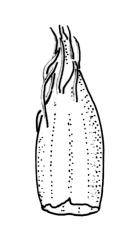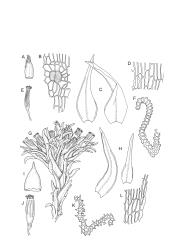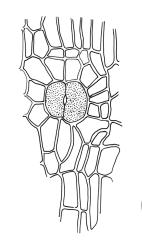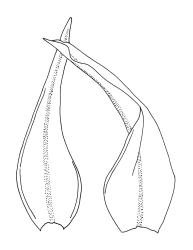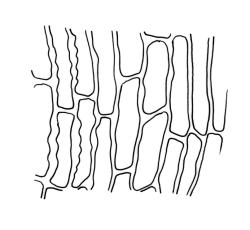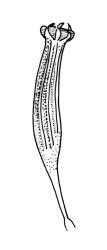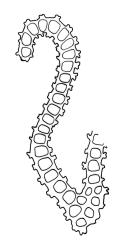- = Orthotrichum breve R.Br.bis, Trans. & Proc. New Zealand Inst. 27: 426 (1895) nom. illeg., non Orthotrichum breve P.Beauv. 1805
- = Orthotrichum brevisetum R.Br.bis, Trans. & Proc. New Zealand Inst. 27: 434 (1895)
Plants 5–20 mm, forming loose and spreading tufts, bright green, yellow-green, or olive-green above, brown to almost black below. Stems erect, much branched by innovation, with well-developed rhizoids ± restricted to base. Leaves erect and slightly flexuose when dry, erect-spreading when moist, ovate-lanceolate, narrowly acute to acuminate, entire, narrowly recurved for most of their length, (2.2–)2.4–3.4 × 0.6–0.9 mm; mid and upper laminal cells isodiametric or slightly elongate, rounded or angular, incrassate, 8–15(–19) × 6.5–12(–14.5) µm, with 2–3 low and ± branched papillae per cell; basal interior cells mostly elongate-oblong, 45–60(–117) × 6–15 µm, thick- or thin-walled, mostly porose, yellow, with several rows at margins shorter, more regularly rectangular, with ± thickened transverse walls, smooth to at least 300 µm above leaf insertion; the papillae of the marginal cells extending further from the base, < c. 5 µm, unbranched. Costa as per genus. Gemmae absent.
Gonioautoicous. Perichaetial leaves not differentiated. Perigonia gemmiform, conspicuous below the perichaetia. Setae c. 0.8–1.5 mm; capsules emergent to short-exserted, oblong-cylindric and often ± swollen at base before maturity, pale brown, strongly 8-furrowed nearly to base and constricted below the mouth when dry, oblong-cylindric and weakly furrowed when moist, 1 per perichaetium (but perichaetia often closely aggregated), persistent and often with several of various ages on a single stem; exothecial cells rectangular, forming 8 bands of relatively thin-walled, unpigmented cells and 8 bands of thicker-walled, pigmented cells (which form ridges when dry); stomata superficial, restricted to mid urn, often surrounded by a ring of radiating cells; operculum as per genus. Peristome double; exostome teeth 8, pale yellow or beige, recurved when dry, sometimes perforate along middle line, the outer surface with ± confluent papillae and horizontal ± vermicular lines, the inner surface papillose with branched or unbranched papillae; preperistome absent; endostome with 8 pale yellow segments, ½–¾ the height of exostome, incurved when dry, narrow, 1 cell wide (sometimes 2 cells near base), the outer surface smooth, the inner surface with papillae and vermicular lines. Calyptra campanulate-mitrate, yellow or pale brown, plicate, not or weakly split at base, with few to numerous hairs reaching to or slightly beyond the calyptra apex. Spores globose, isosporous and 1-celled, 16–21(–23) µm, densely and rather coarsely papillose.
The more strongly ribbed capsules on shorter setae, the pale exostome, and narrower endostome segments serve to distinguish O. hortense from the common and widespread O. tasmanicum.
Orthotrichum hortense differs from O. sainsburyi by having eight pale exostome teeth and eight endostome segments together with short papillae on the laminal cells, rather than 16 orange-red exostome teeth, 16 endostome segments and tall laminal papillae. Although the generally hairy calyptra of O. hortense also contrasts with the ± glabrous calyptra of O. sainsburyi, the confident separation of the two species without well-developed and mature peristomes is very difficult. The two species have a similar distribution.
NI: S Auckland (near Piopio, near Rangitāiki), Hawke’s Bay (Puketītiri, Maraetōtara Scenic Reserve), Wellington (Tangiwai, Erewhon, Palmerston N.); SI: Marlborough, Canterbury, Otago, Southland.
Apparently austral. Recorded from four localities in mainland Australia (N.S.W.) and from South America by Lewinsky-Haapasaari & Ramsay (2006).
Mainly epiphytic, but occurring occasionally on non-calcareous rocks (as at Saddle Hill and at Wanaka, both Otago L.D.). There are isolated records from limestone rock at Broken River, Canterbury L.D. (CHR 105021) and from "waste concrete" from "near Beaumont, Blue Mountains", Otago L.D. (WELT M032880). Reported from a wide range of both indigenous and introduced host tree species by Lewinsky (1984, tab. 1). As in many epiphytic species of Orthotrichum, unmixed collections of O. hortense are exceptional. Orthotrichum hortense is very often mixed with O. calvum, O. sainsburyi, O. tasmanicum, and sometimes other species. Lewinsky (in herb. CHR) named collections with up to five other species of Orthotrichum present. Calyptopogon mnioides and Syntrichia papillosa are also often closely associated. Ranging from near sea level (Christchurch) to at least 860 m (Black Birch Range, Marlborough L.D.).
Lewinsky’s decision to recognise O. hortense as distinct from the widespread northern hemisphere O. affine is adopted here. She discussed in detail both the difficulties of typifying O. hortense and the subtle morphological differences from O. affine. Lewinsky (1984, p. 422) emphasised differences in stance and shape of the dry leaves, which she considered "more erect-open and often somewhat flexuose" and less variable in shape in O. hortense. Given her wide experience with both species, little purpose would be served in questioning her taxonomic conclusion.



